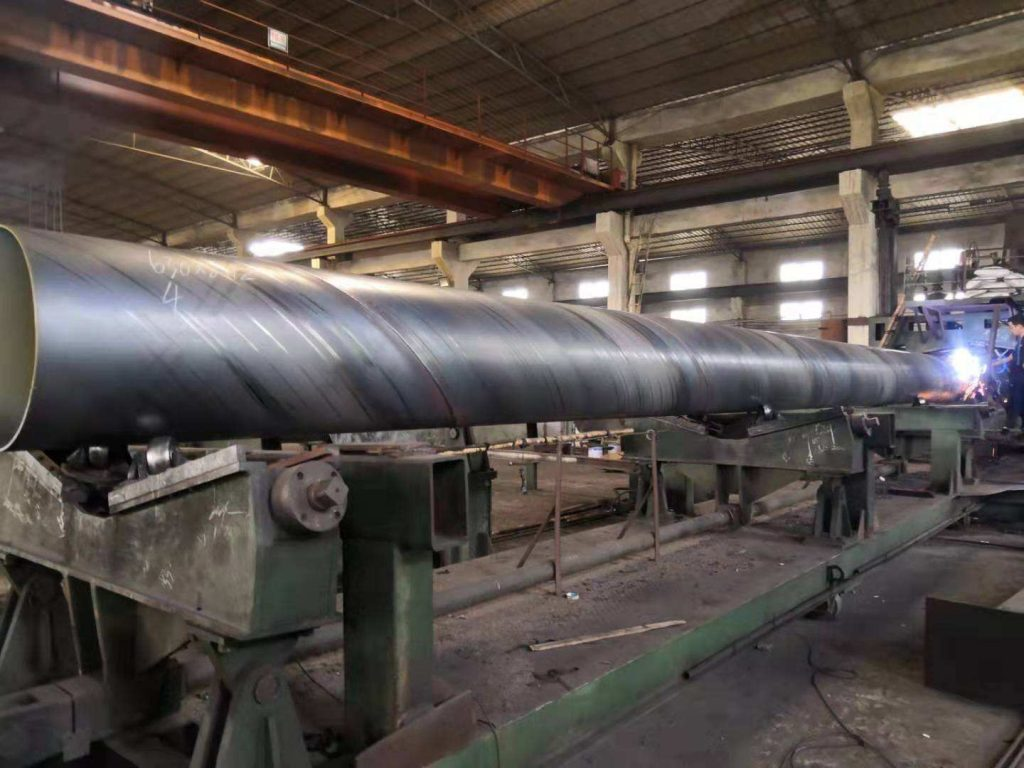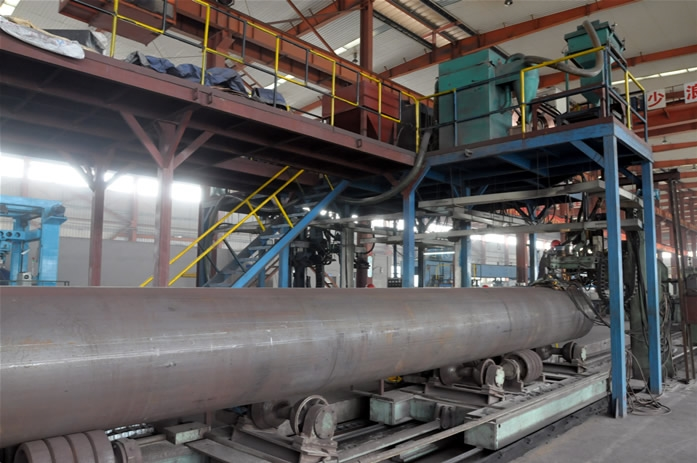Welded steel pipe is seamed steel pipe. Its production is to bend the tube blank (steel plate and steel strip) into a tube with the required cross-sectional shape and size by various forming methods, and then use different welding methods to weld the weld seam together. The process of getting steel pipes.
Compared with seamless steel pipe and welded pipe, it has the characteristics of high product precision, especially wall thickness precision, simple main equipment, small footprint, continuous operation in production, flexible production, and wide product range of the unit.
One, The production process of spiral steel pipe is roughly as follows:
1. The raw materials of spiral steel pipe are strip steel coil, welding wire and flux.
2. Before forming, the strip steel is leveled, trimmed, planed, surface cleaned, transported and pre-bent.
3. The weld gap control device is used to ensure that the weld gap meets the welding requirements, and the pipe diameter, misalignment and weld gap are strictly controlled.
4. After cutting into single steel pipes, the first three steel pipes of each batch must undergo a strict first inspection system to check the mechanical properties, chemical composition, fusion status of the welds, surface quality of the steel pipes and non-destructive testing to ensure that the pipe making process is qualified. After that, it can be officially put into production.

Second, straight seam submerged arc welded pipe:
The straight seam submerged arc welded pipe (LSAW) generally uses steel plates as raw materials, and undergoes different forming processes to form welded pipes by double-sided submerged arc welding and post-welding diameter expansion.
The main equipment includes edge milling machine, pre-bending machine, forming machine, pre-welding machine, diameter expanding machine, etc. At the same time, the forming methods of LSAW pipes include UO (UOE), RB (RBE), JCO (JCOE), etc. The steel plate is first pressed into a U shape in the forming die, and then pressed into an O shape, and then internal and external submerged arc welding is performed. After welding, the diameter (Expanding) at the end or the entire length is usually called UOE welded pipe, and the one without diameter expansion is called UOE welded pipe. For UO welded pipe. The steel plate is rolled into shape (Roll Bending), and then internal and external submerged arc welding is carried out. After welding, the diameter is expanded into RBE welded pipe or RBE welded pipe without diameter expansion. The steel plate is formed in the order of J-C-O-type, and after welding, the diameter is expanded into JCOE welded pipe or JCO welded pipe without diameter expansion

UOE LSAW pipe forming process:
The three main forming processes of the UOE LSAW steel pipe forming process include: steel plate pre-bending, U forming and O forming. Each process uses a special forming press to complete the three processes of pre-bending the edge of the steel plate, U forming and O forming in sequence, and deform the steel plate into a circular tube.
JCOE LSAW pipe forming process:
Forming: After multiple step-by-step stamping on the JC0 forming machine, first half of the steel plate is pressed into a “J” shape, and then the other half of the steel plate is pressed into a “J” shape to form a C” shape, and finally pressurized from the middle so that Form the open “0″ shape tube stock.
Comparison of JCO and UO molding methods:
JCO forming is progressive pressure forming, which changes the forming process of steel pipe from two steps of UO forming to multi-step. During the forming process, the deformation of the steel plate is uniform, the residual stress is small, and the surface does not produce scratches.
The processed steel pipes have greater flexibility in the size and specification range of diameter and wall thickness, and can produce both large-scale and small-scale products; it can produce large-diameter high-strength thick-wall steel pipes, and can also produce Small-diameter and thick-walled steel pipes; especially in the production of high-grade thick-walled pipes, especially small and medium-diameter thick-walled pipes, which have incomparable advantages over other processes.
It can meet more requirements of users in terms of steel pipe specifications. The investment is small, but the production efficiency is low, and the general annual output is 100,000 to 250,000 tons.
UO molding is formed by U and O two times of pressure molding. It is characterized by large capacity and high output. Generally, the annual output can reach 300,000 to 1 million tons, which is suitable for mass production of a single specification.
3. Straight seam high frequency welded pipe:
Straight seam high-frequency welded pipe (ERW) is to heat and melt the edge of the tube billet by using the skin effect and proximity effect of high-frequency current after the hot-rolled coil is formed by the forming machine, and the pressure welding is carried out under the action of the extrusion roller to achieve production.
Welded steel pipe, also known as welded pipe, is a steel pipe made of steel plate or strip steel after crimping and welding. Welded steel pipe has simple production process, high production efficiency, many varieties and specifications, and less equipment investment, but its general strength is lower than that of seamless steel pipe.
Since the 1930s, with the rapid development of continuous rolling production of high-quality strip steel and the advancement of welding and inspection technology, the quality of welds has been continuously improved, and the varieties and specifications of welded steel pipes have increased day by day. Seam steel pipe. Welded steel pipes are divided into straight seam welded pipes and spiral welded pipes according to the form of the weld seam.
Classification by production method: process classification – arc welded pipe, electric resistance welded pipe, (high frequency, low frequency) gas welded pipe, furnace welded pipe. The production process of straight seam welded pipe is simple, the production efficiency is high, the cost is low, and the development is rapid. The strength of the spiral welded pipe is generally higher than that of the straight seam welded pipe, and the welded pipe with a larger diameter can be produced with a narrower billet, and welded pipes with different diameters can be produced with the same width billet. But compared with the straight seam pipe of the same length, the weld length is increased by 30~100%, and the production speed is lower.
Product Standards
Commonly used materials for welded pipes are: Q235A, Q235C, Q235B, 16Mn, 20#, Q345, L245, L290, X42, X46, X60, X80, 0Cr13, 1Cr17, 00Cr19Ni11, 1Cr18Ni9, 0Cr18Ni11Nb, etc.
The blanks used for welded steel pipes are steel plates or strip steel, which are divided into furnace welded pipes, electric welding (resistance welding) pipes and automatic arc welded pipes due to their different welding processes. Because of its different welding forms, it is divided into two types: straight seam welded pipe and spiral welded pipe. Because of its end shape, it is divided into round welded pipe and special-shaped (square, flat, etc.) welded pipe. Due to their different materials and uses, welded pipes are divided into the following varieties:
GB/T3091-2001 (galvanized welded steel pipe for low-pressure fluid transmission). Mainly used for conveying water, gas, air, oil and heating hot water or steam and other general lower pressure fluids and other purposes. Its representative material is: Q235A grade steel.
GB/T14291-2006 (welded steel pipes for mine fluid transport). It is mainly used for straight seam welded steel pipes for mine compressed air, drainage, and shaft discharge gas. Its representative material is Q235A and B grade steel. GB/T14980-1994 (large-diameter electric-welded steel pipes for low-pressure fluid transportation). Mainly used for conveying water, sewage, gas, air, heating steam and other low-pressure fluids and other purposes. Its representative material is Q235A grade steel.
GB/T12770-2002 (stainless steel welded steel pipes for mechanical structures). Mainly used in machinery, automobiles, bicycles, furniture, hotel and restaurant decoration and other mechanical parts and structural parts. Its representative materials are 0Cr13, 1Cr17, 00Cr19Ni11, 1Cr18Ni9, 0Cr18Ni11Nb, etc.
GB/T12771-1991 (stainless steel welded steel pipes for fluid transportation). It is mainly used for conveying low-pressure corrosive media. Representative materials are 0Cr13, 0Cr19Ni9, 00Cr19Ni11, 00Cr17, 0Cr18Ni11Nb, 0017Cr17Ni14Mo2, etc.
In addition, welded stainless steel pipes for decoration (GB/T 18705-2002), welded stainless steel pipes for architectural decoration (JG/T 3030-1995), large-diameter electric welded steel pipes for low-pressure fluid transmission (GB/T 3091-2001), and Welded steel pipes for heat exchangers (YB4103-2000).
Production technology and process
The production process of straight seam welded pipe is simple, the production efficiency is high, the cost is low, and the development is rapid. The strength of the spiral welded pipe is generally higher than that of the straight seam welded pipe, and the welded pipe with a larger diameter can be produced with a narrower billet, and welded pipes with different diameters can be produced with the same width billet. But compared with the straight seam pipe of the same length, the weld length is increased by 30~100%, and the production speed is lower.
Welded pipes with large diameter or thicker diameters are generally directly made of steel billets, while small welded pipes and thin-walled welded pipes only need to be directly welded by steel strips. Then after a simple polishing, brushing on it. Therefore, most of the welded pipes with smaller diameters adopt straight seam welding, and most of the large diameter welded pipes adopt spiral welding.
Supplement: The welded pipe is welded with strip steel, so its status is not as high as that of the seamless pipe.
Welded pipe process
Raw material decoiling—leveling—end cutting and welding—loop—forming—welding—removal of inner and outer welding beads—pre-calibration—induction heat treatment—sizing and straightening—eddy current testing— Cutting-water pressure inspection-pickling-final inspection (strict check)-packing-shipping.
Post time: Jan-09-2023